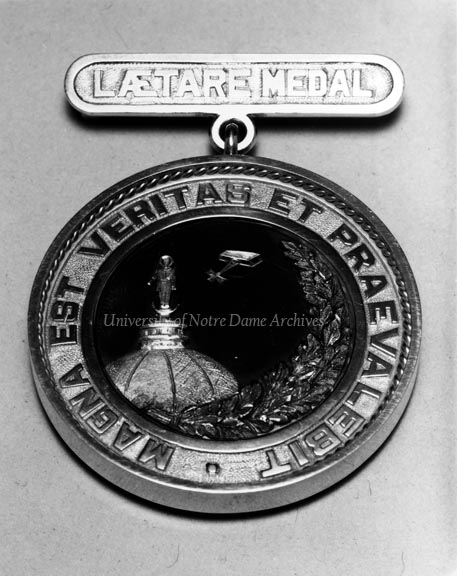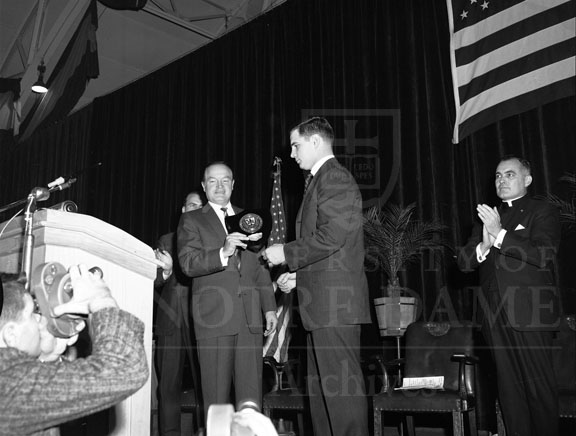
In the early 1880s, the Notre Dame faculty and administration were discussing a way to engage American Catholic lay men and women with the hierarchy of the Church. University President Rev. Thomas Walsh, Rev. Edward Sorin, and Professor James Edwards decided that Notre Dame should bestow a medal of honor each year on an American lay Catholic member, preferably a college-educated “man of letters,” in similar fashion as the Vatican’s Golden Rose. The Laetare Medal quickly became not only the highest honor Notre Dame bestows, but also the highest honor American Catholics can receive.
As the medal was initially presented on Laetare Sunday, the fourth Sunday of Lent, the medal was known as the Laetare Medal. Notre Dame administrators or a delegate usually presented the medal to the recipient away from campus. As time grew on, the presentations floated further away from Laetare Sunday to accommodate the recipient’s schedule, but the announcement is still made on Laetare Sunday.

John Gilmary Shea was the first recipient of the Laetare Medal in 1883. Artist Eliza Allen Starr, dear friend of Rev. Edward Sorin, was the third recipient of the Laetare Medal and the first female recipient in 1885. Edward Pruess accepted the 1887 medal under anonymity, not wanting public honors. It wasn’t until after his death that his name was added to the honor roll.
In the early years, an illustrative announcement accompanied the medal. This practice ended in 1908 on the Silver Jubilee of the Laetare Medal. Each medal has a unique design, reflecting an important aspect of the recipient’s life. For example, aviation pioneer Albert Zahm’s (Class of 1883) medal features an airplane and the Golden Dome (see above) while President John F. Kennedy’s medal features the Presidential Seal of the United States.

Artwork by Howard Darnell of Philadelphia.
For decades, Notre Dame administrators, usually accompanied by the local bishop or other Catholic hierarchy, would bring the medal to the recipient. Usually the ceremony was simple, but other times it was a lavish affair. In 1911, former Notre Dame professor Maurice Francis Egan, who was then service as the United States Ambassador to Denmark, was awarded the Laetare Medal. Notre Dame invited dozens of dignitaries, including cabinet members, congressmen, high-ranking military officials, and foreign ambassadors to the presentation ceremony.
In 1918, Los Angeles Bishop John Cantwell spoke to a packed crowd in the Shrine Auditorium on the occasion of the Laetare Medal presentation to attorney Joseph Scott:
“This distinguished assemblage of citizens is unique among civic gatherings. We come together this evening to witness an academic act of a university whose center is far from here, but whose range of activity is confined only by the continent. … When the University of Notre Dame confers the Laetare Medal this evening, it is the witness of a great university to the superb character of Mr. Joseph Scott.”
[“Joseph Scott Receives the Laetare Medal,” The Tidings, February 28, 1919; CJWC 14/22]
For the Golden Jubilee of the medal in 1933, the presentation was held at Notre Dame’s Commencement. All living medalists were invited and among those who returned to campus to speak were Margaret Anglin, Al Smith, and Dr. James J. Walsh.

In 1968, the Notre Dame search committee opened up the requirements of Laetare Medalists to include clergy, not just lay people. The first religious Laetare Medalist was Rev. John O’Brien, a Notre Dame faculty member and popular author. Notre Dame has also awarded the Laetare Medal jointly to married couples and groups.
By the 1970s, the presentation of the Laetare Medal became a regular part of Commencement Exercises, and the medal recipient is one of the principle speakers. In 2006, Laetare Medalist jazz musician Dave Brubeck also graced the audience with a performance of “Travelin’ Blues” (see video below). In 2009, Mary Ann Gleason declined the Laetare Medal in protest to Notre Dame’s decision to name President Barack Obama as Commencement speaker and award him an honorary degree.

For the centennial of the Laetare Medal in 1983, University President Rev. Theodore M. Hesburgh admitted,
“there was serious discussion whether the University should continue to make the annual award. After all, with twenty-one Catholic members of the United States Senate, we are hardly an immigrant minority; we have entered the mainstream. But the consensus was that our nation will always need – and it will be salutary to recognize – the kind of men and women who have worn the Laetare Medal, persons of excellence and faith who exemplify best what it means to be both American and Catholic. For this reason, I suspect that there will be a Laetare Medal as long as there is a Notre Dame”
[Laetare Medal Centennial: 1883-1983, PNDP 40-La-01].
Sources:
Scholastic
Alumnus
Notre Dame: One Hundred Years by Arthur J. Hope
CJWC 14/22
PNDP 40-La-01
GNEG 02D/24B
GLAE
GPHR 45/4321
GPHR 35m/05764
“Declining Notre Dame: A Letter from Mary Ann Glendon,” Mary Ann Glendon, April 27/2009 (http://www.firstthings.com/blogs/firstthoughts/2009/04/declining-notre-dame-a-letter-from-mary-ann-glendon/)
List of Laetare Medal Recipients


 Tickets and press credentials for the Washington Day Exercises, 1960-1964
Tickets and press credentials for the Washington Day Exercises, 1960-1964 Senator John F. Kennedy receiving the Patriot of the Year Award from Senior Class President George Strake at the Washington Day Exercises, February 1957.
Senator John F. Kennedy receiving the Patriot of the Year Award from Senior Class President George Strake at the Washington Day Exercises, February 1957. 

 Program cover from the 1965 Washington Day Exercises and Patriot of the Year Award Ceremony. R. Sargent Shirver Jr. received the award this year.
Program cover from the 1965 Washington Day Exercises and Patriot of the Year Award Ceremony. R. Sargent Shirver Jr. received the award this year.